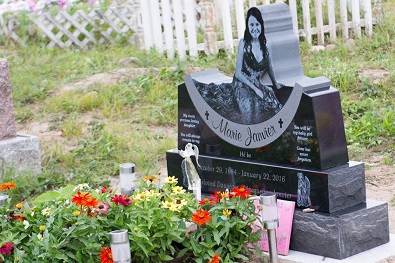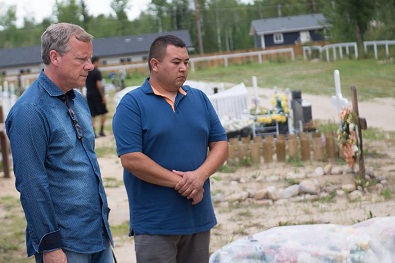Brad Wall and Mayor Kevin Janvier visit the headstone and gravesite of Marie Janvier. Photo courtesy Brad Wall, Facebook
There are certain days in a person’s life, where everything that happened before or will happen after is separated by that day.
In La Loche, every person marks the same day – January 22, 2016 – as a defining one in his or her life. That’s the day a shooter went into the home where teen brothers Dayne Fontaine and Drayden Fontaine were, and killed them. The shooter then went to the high school and opened fire, injuring seven and killing Mark Wood and Marie Janvier.
Village administrator Janine Boucher describes how those events affected her.
“It was extremely devastating having grown up here, having gone to school here,” she said, adding that it’s led to a sense of resolve as she helps with local initiatives and acts on the board of the Northern Lights School Divison.
“There are certain realities that we have to face when it comes to the social aspect of it. And if we continue to deny what has been going on or what’s gone on, then we will be no further ahead than we were previous to January 22, 2016.”
That’s why when Prime Minister Justin Trudeau and Premier Brad Wall visited in the aftermath of the shooting, leadership from the La Loche area identified four priority areas. A number of groups locally, provincially and federally formed subcommittees focused on health, housing, education and infrastructure.
On Tuesday, Boucher was among more than 100 people gathered in La Loche high school’s Dene Building gym when Wall returned to make announcements based on the work of those subcommittees. Tuesday also marked the first day after a beautiful headstone for Marie Janvier was placed in the graveyard. A memorial service for Janvier took place just after that event.

Marie Janvier’s headstone. Photo courtesy Brad Wall, Facebook
“Thank you for refusing to give in to despair,” Wall told the crowd at the emotional event.
However, there are moments of despair in La Loche. They can take the form of suicides, including one that took place recently.
Also, last week, a young girl attempted to end her life by taking pills. She pulled through and is now recovering in Saskatoon, said the Friendship Centre’s executive director Leonard Montgrand.
This fall, the recently opened new building for the Friendship Centre will be home base for many new positions, which were a part of Wall’s announcement. A suicide prevention worker is among them, along with a community mental health nurse, victims services worker, and half-time community justice coordinator.
Montgrand said these provincial improvements need to be accompanied by community efforts so nothing like the events of January 22 happen again.
“The biggest problem we have in our community, I’ll be honest with you, is finding strong, passionate people that are able to carry a lot of the work load and a lot of the burden,” he said.
“All the stuff falls on the shoulders of a few.”
Montgrand is one of those “few.” He has been a part of the increased Friendship Centre programming since the events of January 22, and said the community expects the centre to continue operating the same as it used to.
“It’s impossible. There’s just too much and it causes burnout, tiredness and the programs don’t get delivered to the full extent that they should be at times,” he said.
On a daily basis, Montgrand and other staff work with 16 summer students, have started a boxing club, run after-school programs, run culture camps, and operate numerous other programs.
On top of all that, Montgrand is part of a small group of residents who apply for grants on a regular basis. It might seem like a small task on the surface, but the results would eliminate the high staff turnover, he said.
Funding would provide a guarantee that a program can last longer than six months or a year, providing three or five years of job stability for those who run the programs.
At one point, Montgrand thought a provincial solution was in store for an inter-agency committee position to seek grants and to bring together different organizations to work as a team so that work can be spread out more evenly.
“That’s what I really wanted to see in the community and I was excited when I was told that was a possibility, but that has gone to the wayside since then. That’s one of the things I was kind of disappointed in,” he said.
To consider the current situation in La Loche as a steep uphill climb would be “an understatement. I’m just, I don’t know what to do half the time to be honest with you. I’m so inundated, can’t even take holidays and when you do you gotta mix them in with work.”
Montgrand added that Wall’s announcement is not the end of a push to get the inter-agency position.
Boucher echoes the need to keep pushing the province. She also agrees that community uptake is needed.
“For us to move ahead, we always have to make sure that we come back to January 22, 2016, to make sure we’re headed in the right direction.”
